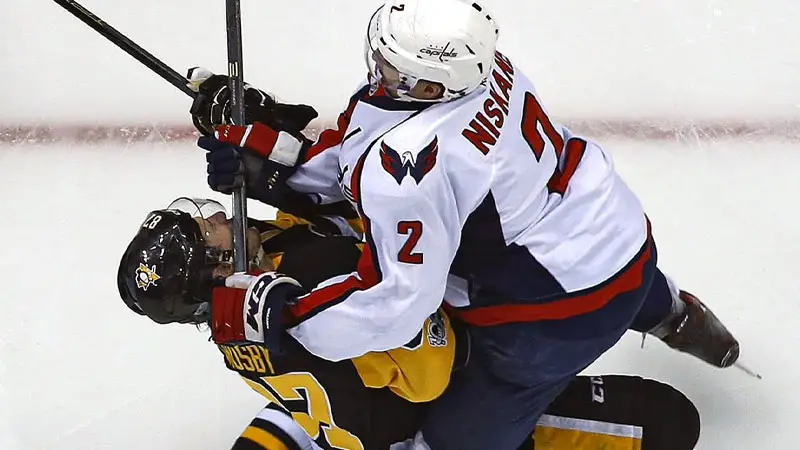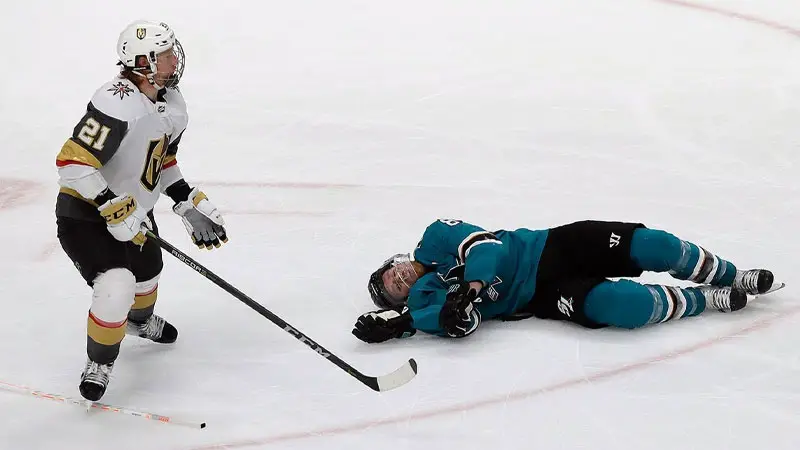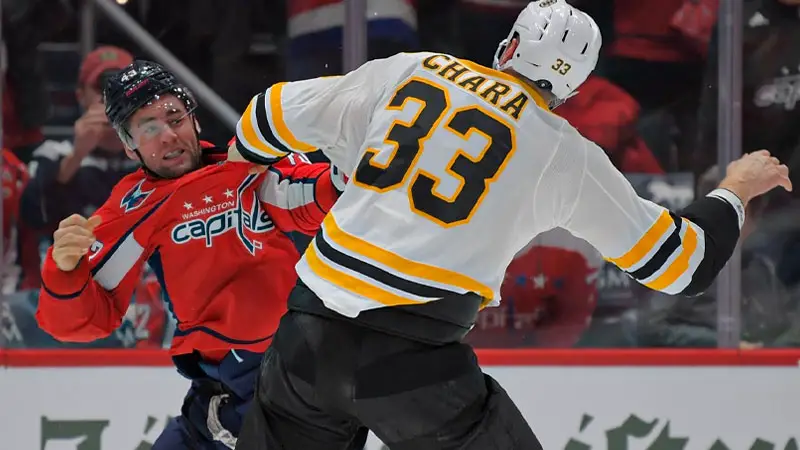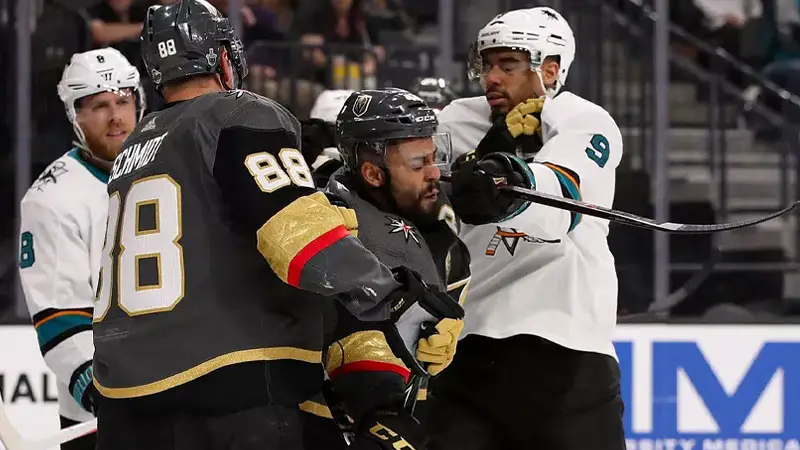Hockey, a fast-paced and exhilarating sport, is renowned for its intense physicality and strategic gameplay.
Amidst the skillful stickhandling, precise passes, and powerful shots, there exists a facet of the game that often raises eyebrows and sparks debates – hockey cross-checking.
This controversial maneuver involves a player using the shaft of their hockey stick to forcefully check an opponent, leading to frequent infractions and penalties.
In this feature snippet, we delve into the intricacies of hockey cross-checking, exploring the rules governing this action, the penalties it incurs, and the paramount importance of player safety.
As we unravel the nuances of this contentious aspect of the game, we aim to shed light on how hockey cross-checking adds both intensity and controversy to the world of hockey. Stay focused.
What Is Hockey Cross-Checking?
Hockey cross-checking is a contentious on-ice maneuver defined by the deliberate use of the shaft of a player’s hockey stick between their two hands to forcefully check an opponent, all while ensuring that no part of the stick makes contact with the ice.
This distinct action is characterized by its potential for heightened physicality and is subject to stringent rules within the realm of hockey.
In essence, a player engages in cross-checking when they employ the stick as a lever, leveraging its shaft to exert force on an opponent, often in an attempt to gain a strategic advantage or disrupt their play.
The prohibition of any part of the stick touching the ice during this move underscores its distinctiveness and distinguishes it from other forms of checking in the sport.
As a result, understanding the nuances of hockey cross-checking is crucial for players, officials, and fans alike, contributing to both the thrill and controversy that surrounds this dynamic sport.
Strategies to Minimize Cross-Checking Incidents in Hockey
In the fast-paced and physically demanding world of hockey, minimizing cross-checking incidents is crucial for fostering a safer and fairer playing environment. Here are some strategies to achieve this goal:
Educate Players on Rule Interpretation
Providing thorough education on the rules surrounding cross-checking is paramount.
Players should have a clear understanding of what constitutes a cross-checking infraction, emphasizing the prohibition of any part of the stick touching the ice during the maneuver.
Workshops, training sessions, and informational materials can help disseminate this knowledge.
Promote Respect for Opponents
Instilling a culture of respect among players is key to reducing cross-checking incidents.
Emphasizing fair play and encouraging sportsmanship not only contributes to a healthier playing atmosphere but also diminishes the inclination to engage in overly aggressive tactics, such as cross-checking.
Enhance Officiating and Enforcement
Improving officiating standards and enforcement of rules during games can act as a deterrent.
Consistent and vigilant referees play a pivotal role in identifying and penalizing cross-checking infractions promptly. This ensures that players recognize the consequences of such actions.
Emphasize Player Safety Initiatives
Implementing comprehensive player safety initiatives, both in training and during games, can significantly reduce the occurrence of cross-checking.
Teaching proper body-checking techniques and reinforcing the importance of avoiding dangerous plays contribute to a safer on-ice environment.
Leverage Technology for Review and Analysis
Incorporating technology, such as video review systems, can aid in assessing and penalizing cross-checking incidents accurately.
This allows for a more precise evaluation of player actions and promotes accountability, serving as a deterrent while also ensuring fair and just outcomes.
Evolution of Cross-Checking Rules in Hockey

The evolution of cross-checking rules in hockey reflects a continuous effort to balance the physicality of the sport with player safety and fair play.
Over the years, these regulations have undergone significant changes. Here’s a look at the key points in the evolution of cross-checking rules:
Historical Tolerance and Emergence of Safety Concerns
In the early years of hockey, cross-checking was often tolerated to a greater extent, reflecting the rugged nature of the game.
However, as safety concerns gained prominence, especially regarding high sticks and dangerous plays, the need for more stringent regulations became apparent.
Introduction of Clear Definitions and Standards
As the sport matured, hockey governing bodies began to introduce clear definitions of cross-checking and established standards to differentiate it from other forms of legal body-checking.
This step aimed to provide players, coaches, and officials with a more precise understanding of what constituted an infraction.
Strict Enforcement and Penalties
With a growing emphasis on player safety, the enforcement of cross-checking rules became more rigorous.
Penalties for engaging in cross-checking, particularly in a way that endangered opponents, were heightened.
This shift intended to discourage overly aggressive play and promote a safer on-ice environment.
Technological Advancements in Officiating
The integration of technology, such as video replay systems, has played a role in refining the enforcement of cross-checking rules.
Video reviews allow officials to scrutinize plays more closely, ensuring accurate identification of infractions and fair application of penalties.
Adaptation to Changing Styles of Play
As playing styles and tactics evolve, so do the rules surrounding cross-checking.
Amendments are made to accommodate changes in the game while maintaining a delicate balance between physicality and safety. This adaptability ensures that the rules remain relevant in the context of contemporary hockey.
Controversies Surrounding Cross-Checking in Hockey

Cross-checking in hockey has long been a source of controversy, sparking debates among players, coaches, and fans alike.
The contentious nature of this maneuver has led to heated discussions surrounding its impact on the game.
Here are several points highlighting the controversies surrounding cross-checking in hockey:
Subjectivity in Officiating
One of the primary controversies is the subjectivity involved in officiating cross-checking incidents. The interpretation of the rules can vary among referees, leading to inconsistent calls.
This inconsistency has sparked debates about the fairness and impartiality of officiating decisions.
Balance Between Physicality and Safety
Cross-checking embodies the fine line between the physical nature of hockey and ensuring player safety.
The debate often centers around finding the right balance, allowing a level of physical play that makes hockey exciting while preventing dangerous and injurious actions.
Impact on Player Safety
The forceful nature of cross-checking raises concerns about player safety. Incidents where players are checked from behind or into the boards with excessive force can result in injuries.
This has prompted discussions about whether stricter regulations are needed to mitigate the risks associated with this maneuver.
Strategic Use of Cross-Checking
Some controversies stem from the strategic use of cross-checking during crucial moments in a game.
Players may employ this tactic to gain a competitive advantage, disrupt opponents, or create scoring opportunities.
The ethical implications of using cross-checking as a strategic tool contribute to ongoing debates.
Calls for Rule Revisions
Periodically, calls for revising cross-checking rules emerge in response to high-profile incidents or shifts in playing styles.
The controversy lies in finding a consensus on rule adjustments that address safety concerns without compromising the essence of the game or impeding its natural flow.
Navigating the controversies surrounding cross-checking in hockey involves considering the perspectives of players, officials, and fans, all while striving to maintain the integrity of the sport.
Consequences of Cross-Checking in Hockey

Cross-checking in hockey, a physically demanding sport, can have significant consequences that extend beyond the immediate play on the ice.
Understanding the repercussions of this maneuver sheds light on its impact on players and the game as a whole. Here are several points outlining the consequences of cross-checking in hockey:
Penalties and Power Plays
The most immediate consequence of a cross-checking infraction is the imposition of penalties.
Players engaging in cross-checking can expect to spend time in the penalty box, leaving their team shorthanded.
This not only affects the team’s defensive capabilities but also provides the opposing team with a power play opportunity to capitalize on the numerical advantage.
Injuries and Player Safety Concerns
Cross-checking, especially when executed with excessive force or in dangerous areas of the ice, poses a significant risk of injuries.
Players subjected to forceful cross-checks, particularly along the boards or from behind, may experience injuries ranging from minor bruises to more severe conditions like concussions or musculoskeletal injuries.
Team Dynamics and Momentum Shifts
The ejection of a player due to a cross-checking penalty disrupts team dynamics and can lead to momentum shifts in a game.
The loss of a key player, even temporarily, can alter the course of a match and impact a team’s ability to execute strategies effectively.
Game Suspension and Fines
In cases of particularly egregious cross-checking incidents, players may face game suspensions and fines.
These consequences extend beyond the immediate game and can have financial implications for the player. This serves as a deterrent and emphasizes the league’s commitment to player safety.
Reputational Impact
Repeated instances of cross-checking or involvement in high-profile incidents can tarnish a player’s reputation.
This can influence how they are perceived by teammates, opponents, and fans, affecting their standing in the hockey community and potentially impacting career opportunities.
The consequences of cross-checking highlight the need for players to balance the physical aspects of the game with a commitment to fair play and safety.
FAQs
What penalties can result from cross-checking?
Cross-checking penalties lead to time in the penalty box, leaving the offending team shorthanded.
The severity of penalties depends on the nature and impact of the infraction, ranging from minor penalties to major penalties or even ejection from the game.
How is cross-checking officiated during a game?
Officiating cross-checking involves referees closely monitoring player actions. Any use of the stick’s shaft between the hands to check an opponent is subject to penalties.
Referees strive to ensure consistent enforcement, though interpretations may vary, leading to occasional debates over the calls.
Are there specific areas where cross-checking is more likely to occur?
Cross-checking can occur anywhere on the ice, but it’s often seen along the boards or in front of the net.
These areas present opportunities for players to use the stick’s leverage to disrupt opponents. However, any such action, regardless of location, is subject to penalties.
How has the regulation of cross-checking evolved over time?
The regulation of cross-checking has evolved to prioritize player safety. Initially tolerated to a greater extent, clear definitions and stricter enforcement have been introduced.
The rules adapt to changes in playing styles and technology, aiming to balance the physicality of the game with the safety of its participants.
Wrapping Up
In the dynamic world of hockey, cross-checking stands as a focal point, embodying the sport’s physicality and the ongoing quest for balance.
From its historical tolerance to contemporary debates, the evolution of rules reflects a commitment to player safety. Controversies and consequences underscore the need for careful regulation.
As the game progresses, strategies to minimize incidents continually adapt, ensuring that the thrill of hockey remains intact while upholding fair play and the well-being of its participants. Thank you so much.








James Felix